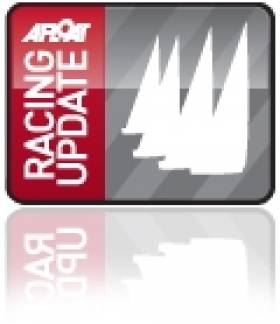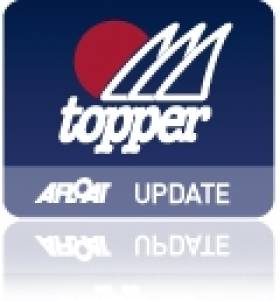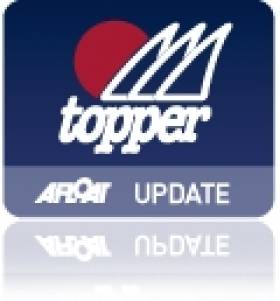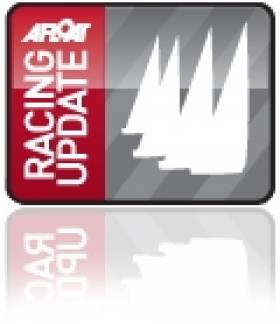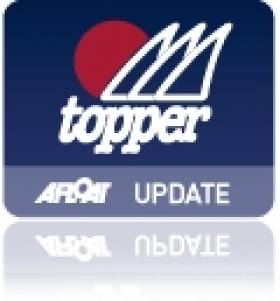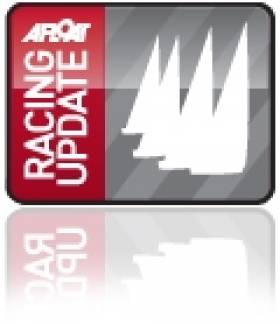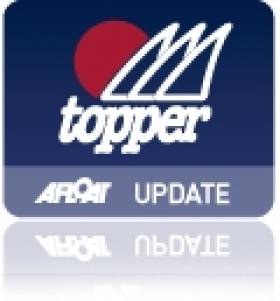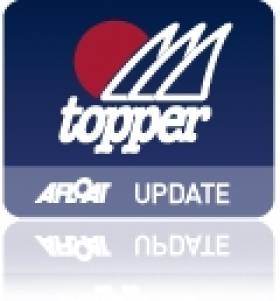Displaying items by tag: Topper
Racing Round Up; Toppers, Optimists, SB3s, DBSC, Fastnet, IRC, Star
15 year old Matt Venables from Sutton Coal Fields Yacht Club in Birmingham proved that he is a potential Olympian with his dominant win of the very successful Sovereign Ski Topper World Championships which finished in Dun Laoghaire today writes Martin McCarthy.
The youngster led from the second race on day 1 and was comfortably in front by the time Race OOD Con Murphy finished the third race of the day.
Matt was delighted with his win: "The whole event has been amazing – I have enjoyed every minute of it. The set up here and the organization has been fantastic – the courses were superb and it was great that we got all our races in despite a lot of light airs"
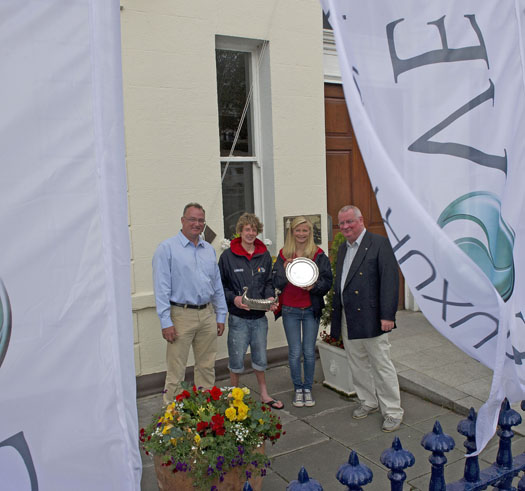
National Yacht Club Commodore Paul Barrington, who doubled as Event safety officer, was impressed with the huge fleet's behaviour: "The sailors showed great rule adherence – especially as they are all under 18 – but they also really entered into the right spirit for the event." The five dolphins who joined the later races also seemed to be enjoying the fun of the occasion.
This spirit was what also struck Event Chairman Margaret Kneafsey: "There was great friendliness in the fleet despite the fierce competitiveness. They all seemed to enjoy themselves no matter where they finished"
Top of the Irish was Patrick Crosbie of RCYC who finished a brilliant third out of the 177 boat fleet. He said it was one of the most enjoyable events he has ever done. He will only have tonight to rest before heading to Wales to compete in the British 420 Nationals in North Wales where he is teaming up with his sister.
Strangford's Laura Gilmore also had a terrific championship finishing fifth overall and is now the best female Topper sailor in the world.
The 5 man Korean team added a true global flavour to the Dun Laoghire event. Their manager Mr.Lee felt they leant a great deal from the Dun Laoghaire event as they will host the 2013 Topper World's: "It was great for our boys to sail against the world's best and we were proud that one got into the silver fleet. Staying in UCD worked very well as the boys could play football in the evenings with Irish and British boys and I think they will have friends for life from that". He also remarked that the Harbour Company providing the Carlisle Pier for Camper vans added greatly to the atmosphere and spirit of the event.
Phil Harland adds: Sailors arrived for the final day of the 2011 Sovereign Ski Topper World Championship at the National Yacht Club in Dun Laoghaire, Ireland to be greeted by yet another day of calm seas and no wind. Those fervently looking at the forecasts were predicting some big winds coming over around 11:00am with a front of rain, but having arrived an hour early at the club based on yesterday's forecast of wind in the morning there were a few weary faces around the dinghy park.
Launching was delayed as the wind stubbornly refused to get going, and then at 10:00am a gentle breeze rustled through. There was rumour of 20 knot winds just down the coast at Wicklow as the PRO gave the decision to launch and the sailors took to the water in eager anticipation. Once again launching was completed quickly and efficiently. As the wind started to fill in, Gold fleet went into sequence at 10:50, which ended in a general recall. Second time around though they were clean away with a big pin end bias as the wind shifted.
Silver fleet got away cleanly with three Irish boats port tacking the fleet off the biased pin end. Bronze fleet were also finally away, though a bit of a messy start in the shifting wind. As the Silver fleet rounded their windward mark a few spots of rain started falling out on the course, and the wind dropped – now averaging less than 5 knots much to the frustrations of the sailors who had been expecting it get stronger through the day! The tide was still ripping through and with little wind the Bronze fleet was moving very slowly towards the windward mark and having great difficulty getting around it.
Meanwhile, the Gold fleet, who had been sailing in the best of the breeze, were completing their first race of the day. Eventually Silver and Bronze fleets completed their course. Fleet winners for the first race of the day were: Gold – Danielle Rowe (GBR); Silver – Lewis Marr (GBR); Bronze – Oliver Martindale (GBR).
The wind increased again slightly, but the rumoured winds over Wicklow hadn't made it to Dun Laoghaire! Before the start of Race 2, a wind shift to the right left the PRO no option but to lay a new course before getting Gold fleet away cleanly for Race 2. However, yet another wind shift meant the PRO had to raise the AP for Silver and Bronze fleets. After a short delay Silver went into sequence and eventually after another general recall they got away under a black flag followed by the Bronze fleet. The wind speed out on the race course climbed to 7 knots – which was to prove the best conditions of the day, other than the odd isolated gust.
Fleet winners for the second race of the day were: Gold – Matt Venables (GBR); Silver – Samuel McKay (GBR); Bronze – Fionn O'Farrell (IRL).
The final race of the championship saw Gold fleet away followed by a general recall for Silver fleet and finally Bronze fleet. As the Bronze fleet completed their final race the rain started falling lightly again and the wind dropped off – the strong winds never came for racing, but as often happens started blowing through the boat park as the boats were being packed away! To round off the day, the fleet winners for the third race were: Gold – Robbie Robinson (GBR); Silver – Georgia Grice (GBR); Bronze – Thomas Moore (IRL).
After five days of racing in challenging and sometimes frustrating conditions consisting of mainly light and shifty winds coupled with a strong tide, Matt Venables (GBR) proved the man to catch, in the end finishing 33 points ahead of his nearest rival and taking an obligatory dive into the water on his way in to the slip. Laura Gilmore (GBR) came home 1st female.
The top three in each fleet were:
Gold fleet: 1st – Matt Venables (GBR); 2nd – Robbie Robinson (GBR); 3rd – Patrick Crosbie (IRL);
Silver fleet: 1st – Joe Henderson (GBR); 2nd – Samantha Foster (GBR); 3rd – Samuel McKay (GBR);
Bronze fleet: 1st – Thomas Moore (IRL); 2nd – Conrad Parkinson (GBR); 3rd – Oliver Martindale (GBR);
During the closing speeches, Bill Brassington, President of the International Topper Class Association, announced that the 2012 Topper World Championship will be held at the Sailing Club Workum, in the Netherlands, from August 19th to the 24th. For 2013 the World Championship will travel to the beautiful island of Namhae in South Korea and for 2014 back to the UK and the waters of Tremadog Bay and the Lyn peninsular, hosted by Clwb Hwylio Pwllheli Sailing Club.
School of Dolphins Help Toppers on Their Way
Sailors arrived for day four of the 2011 Sovereign Ski Topper World Championship at the National Yacht Club in Dun Laoghaire to a flat sea and no wind writes Phil Harland. With increasing cloud cover there was no sea breeze forecast in the bay and so sailors prepared to wait on shore whilst the Race Committee went out on the water to check conditions.
Just before 11:00am the PRO decided to release the fleet from the shore to see what could be made of the light winds on the water. With the same efficiency as previous days all sailors were afloat within 30 minutes and making their way out of the harbour.
The Gold Fleet was the first to assemble on the start line and after an initial recall were clear away. Silver fleet were next but with light breeze and tide there was another general recall before they got away with George Haynes (GBR) port tacking the fleet.
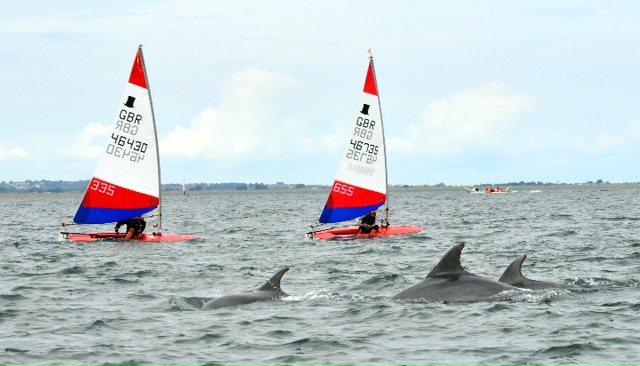
As Bronze went into sequence some newcomers joined in – a school of dolphins – all very friendly, swimming between the boats and jumping out of the water and swimming up the beat with the fleets. So keen were the dolphins to join in that the Bronze fleet start had to be delayed as they dolphins played around the boats on the line. Eventually Bronze fleet got away with a clean start - with the dolphins following them up the beat!
The wind conditions were proving particularly fickle for all the fleets with 45 degree wind shifts and pressure switching from one side of the course to the other leaving sailors who were doing well one minute dropping back down the fleet the next. Hunting pressure was the order of the day.
Fleet winners for the first race of the day were: Gold – Tim Brow (IRL); Silver – Olly Guess (GBR); Bronze – Peter Queally (IRL).
At 13:15 Gold fleet went into sequence for Race 2, but it was another general recall, followed by a clean start second time around. With the wind dropping further, but the chop remaining this was making sailing upwind very difficult. Silver fleet achieved a clean start followed by Bronze fleet, who started Race 2 as soon as they completed Race 1.
With the wind dying further, the Gold and Silver fleets both finished together – and a few dolphins re-appeared to join the fleets. Fleet winners for the second race of the day were: Gold – Matt Venables (GBR); Silver – Samantha Foster (GBR); Bronze – Niamh Doran (IRL).
The PRO tried to get in a third race, but with the wind now almost non-existent decided to send the fleets ashore in the hope of some better wind tomorrow.
With the challenging conditions, results were somewhat topsy-turvy across the fleets, but overnight leaders were: Gold – Matt Venables (GBR) and now with a 22 point lead over the nearest competitor; Silver – Joe Henderson (GBR); Bronze – Thomas Moore (IRL).
The winds forecast for the last day of the event look better and so the Race Committee decided that they would try and go for three races on Friday instead of the planned two, and so have instructed the fleets that will be launching an hour earlier than scheduled.
Cork and Strangford Sailors to the Fore at Topper World Finals
The 173 strong fleet of youth sailors at the Sovereign Ski Topper World Championships produced some surprises on the first day of the finals on Dublin Bay. Having dominated the qualifying series this week, Matt Venables of Sutton YC (UK) found himself edged out somewhat in the Gold fleet, managing two 4ths in the first two finals.

Toppers prepare for a race start. More photos from Gareth Craig on the gallery here.
Ireland's Patrick Crosbie (RCYC) grabbed the first win of the day, just ahead of Laura Gilmore of Northern Ireland, with Gilmore winning race 2 ahead of Britain's Danielle Rowe. It was a strong performance from young Crosbie, named by the ISA earlier this year as Ireland's most promising youth sailor, in his first year of racing toppers.
Newcastle's Joe Henderson dominated in the Silver Fleet finals, taking two strong wins. "I got good starts and played the tide", said the 13year old with ambitions to become a round-the-world racer, adding "it was a nice wind, with light chop but not too much hiking". Once again the girls performed strongly, with Britain's Samantha Foster and Ireland's Alison Dolan both taking 2nd places.
In Bronze fleet Conrad Parkinson of Northern Ireland really upset the form book, having sprung from a best of 22nd in this week's qualifiers to score victories in both of todays races. Ireland's Thomas Moore scored two seconds, with Patrick Butler nabbing a third in the first race. The happy face of Youngwan Kim said it all, as he took a third for Korea in race 2, clearly none the worse for jet lag!
After waiting 2 hours for a sea breeze to settle in, Principle Race Officer Con Murphy ran three races for gold, and two each for silver and bronze in a steady 10kts of wind. "we expect light airs and rain tomorrow for the second day of the finals" said Murphy, adding strong winds are expected on Friday, giving testing conditions to these young sailors. Day 3 Results here.
Below event photos by Michael Chester.
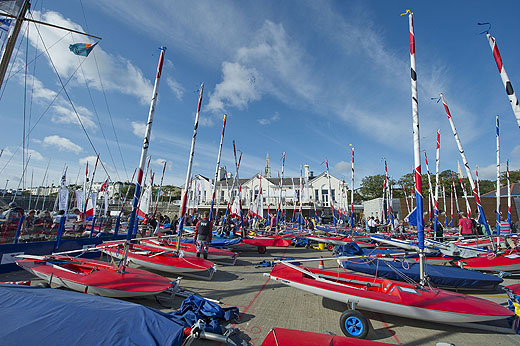
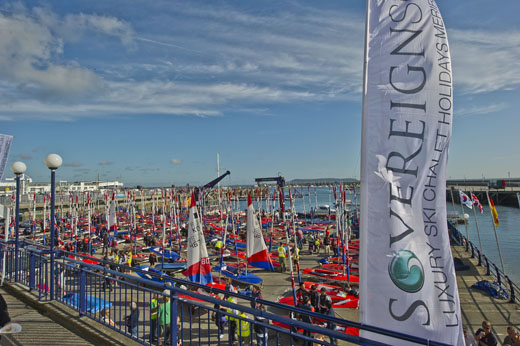
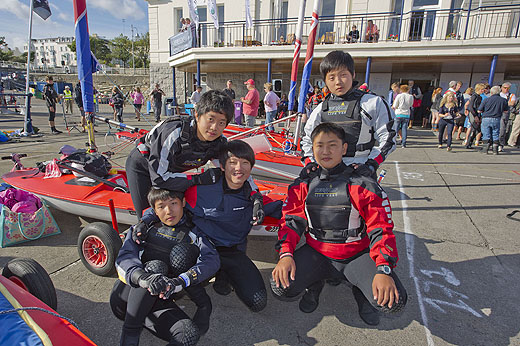


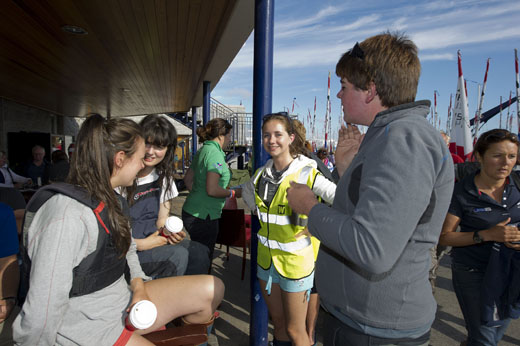

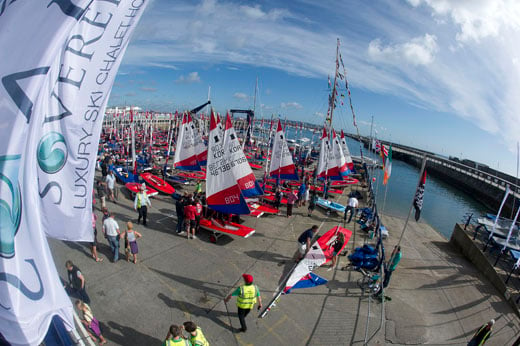
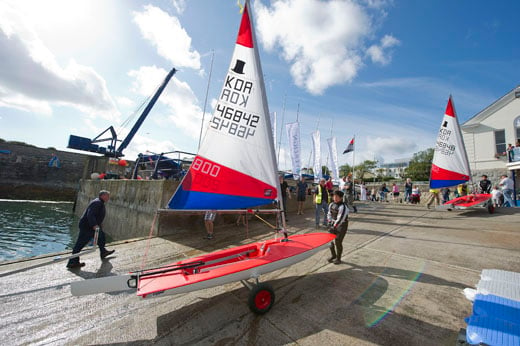
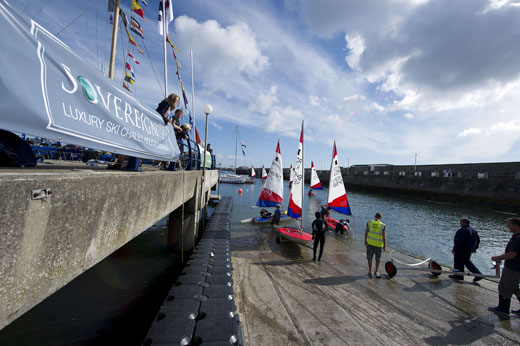
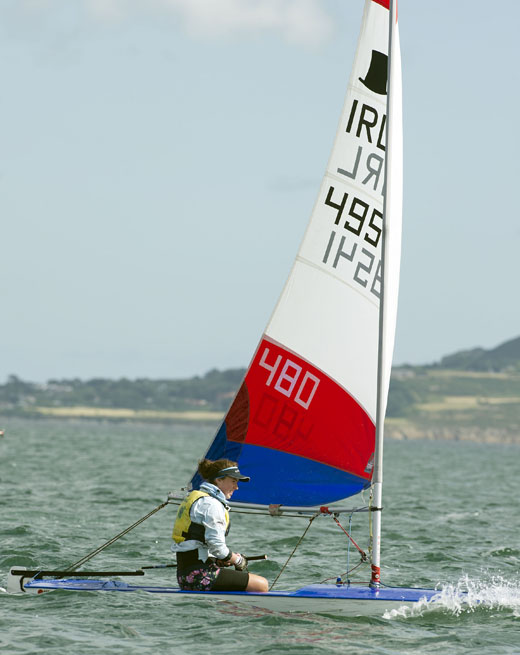
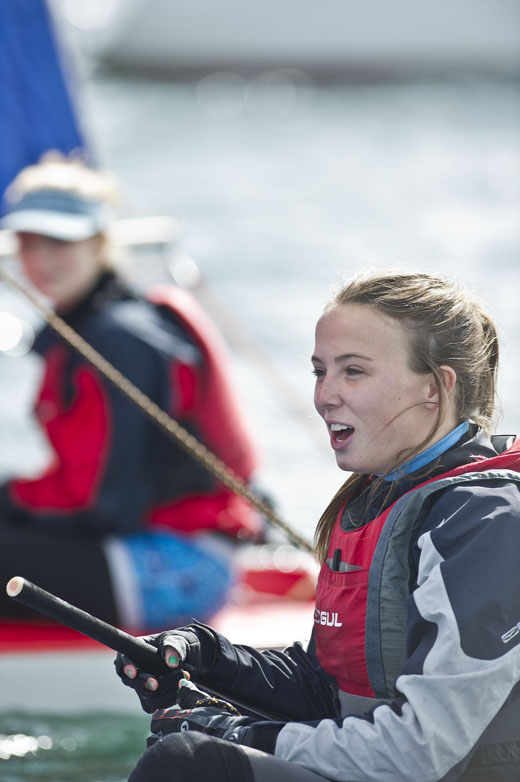


Epic Racing Expected as Toppers Finals Commence
With just three days racing to go before Friday's final race in the Sovereign Ski Topper World Championship at the National Yacht Club, the event is shaping up to be a battle royale. The Qualifying races are over and the 166 boats have been split into bronze, silver and gold fleets - with the first of eight final races being run this (Wednesday) morning.

The start of Race 4 on the 16th August of the Sovereign Ski Topper World Championships
Race Chairperson Margaret Kneafsey is expecting close competitive racing from some of the world's best young sailors.
"Any one of a dozen sailors can win. The two Venables brothers from Sutton YC (UK) are on the UK National squad while Giles Kuzyk won the UK Nationals earlier in the month and so one can expect them to be up near the front". Irish sailors such as Finn Lynch will also be bidding for overall honours. The presence of the Korean squad has raised a lot of positive interest. The reason for their presence is because the Korean National Sailing Assoc. has adopted the same Pathway structure as the Irish Sailing Assoc. – with the Topper being an essential step on the ladder to the top.
Seven races are expected to be run before the finale on Friday afternoon but the lights airs forecast for today (Wed) and tomorrow may impact the race numbers. The forecast for Friday is increasing breeze, setting the scene for a trilling days racing before the 2011 Sovereign Ski Topper World Champion emerges.
Day 2 Results can be found here.
Racing Round up: Olympic, Fastnet, Clipper, Figaro, Dragon, J24, Fifteen, Topper, Feva, Oppy
This morning's edition includes photos and pics from Sunday's Figaro departure from Dun Laoghaire and the Rick Tomlinson's pics of the start of the Fastnet race from Cowes. Derry-Londonderry is on her way to Rio in the Clipper race. Regrettably there was no Gold, Silver or Bronze from Weymouth but we're in a strong position. See our video with Annalise here. Plus: The Topper Worlds at the National YC, John Lavery's win at the Flying fifteen South coast champs in Dunmore East, the J24 Nationals from Lough Erne, A local pair whitewashed the RS Feva Nationals in Cork Harbour, some great shots from Bob Bateman. The Oppy Nationals start in Howth and Afloat's Sailor of the Month for July Martin Byrne retained the Dragon Nationals in Kinsale. There's also the full weekend results from Dublin Bay SC.
Figaro Sails out, Toppers Sail in to the National Yacht Club
Just 8 hours after National Yacht Club Commodore Paul Barrington bade farewell to the 47 brave Solitaire sailors starting their gruelling 420 mile sail back to France, he was raising the curtain on the Sovereign Ski Topper World Championship – one of the world's big sailing event for the professional sailors of the future.
The Figaro stopover was a great success – capturing the imagination of the visitors, the town and the thousands of locals who visited the ships, shops, and fireworks attached to the event.
The tight changeover from Figaro to Toppers was a challenge to the National Yacht Club organizing committee – but there were some great benefits as event Chairman Margaret Kneafsey explained:
" Friday night there was a wonderful fireworks display and festivities put on by Dun Laoghaire Rathdown County Council – but by 7am on Saturday morning the marquee was cleared and taken down so the Topper competitors could take up their places. It has been very inspiring for the young sailors (all under 18) to see the professionalism of the Figaro race and the exciting lives professional sailors can lead."
Margaret and her large team of volunteers have been delighted to have 180 entries including the five young sailors who have travelled from Korea and sampled Dublin Bay waters for the first time yesterday ( Sunday) .
"It has given them some flavour for the currents and tides in Dublin bay, before the start of the qualifying races for the championship finals which will start today ( Monday)" said Margaret.
Today's ( Monday) qualifying races will be a an amazing blaze of colour across Dublin Bay with all 180 boats lining up for 3 races. Following the same tomorrow the fleet will split in silver and gold fleets and continue the white heat of final competition for 3 days and 8 races until World Champion emerges on Friday afternoon.
Sign up and We'll Send You This Weekend's Irish Sailing News
Monday's edition includes photos and pics from Sunday's Figaro departure from Dun Laoghaire and the start of the Fastnet race from Cowes. Will it be Gold, Silver or Bronze from Weymouth? How will Peter, David and Annalise end up at the Pre-Olympics? Plus: The Topper Worlds at the National YC, Flying fifteen South coast champs in Dunmore East, the J24 Nationals from Lough Erne, Teens battle for the RS Feva Nationals in Cork Harbour, the Cove People's Regatta, The Oppy Nationals at Howth and the Dragon Nationals from Kinsale. There's also the full results from Dublin Bay SC and Howth.
Don't miss your free newsletter. Sign up here.
Strangford's Gilmore Finishes Sixth in British Topper Nationals
That concludes the British Nationals, now the class look forward to the Topper Worlds Championships held by the National YC, Dun Laoghaire from the 14-19 August.
Final Irish Results:
GOLD
Laura Gilmore 6th
Timothy Brow 17th
Jack Brien 19th
Dougie Power 25th
Craig Campbell 26th
Erica Ruigrok 60th
Andrew Penney 72nd
Conor O'Farrell 73th
Sorcha Donnelly 79th
Tom Purdon 86th
SILVER
Aisling Keller 5th
Kevin Harrington 40th
Suzanne Flannigan 46th
See here for full results.
Gilmore Leads British Topper Nationals
Laura Gilmore, from Strangford Lough, who has already won the Ulster Championships now leads the top British event going into the last race today.
On Tuesday which was Day 3 of the Championship, the heavens opened up in Scotland. A mammoth amount of rain fell, which coupled with no wind i.e. 1 knot gusting, meant that no races were completed.
With only two races completed the qualification series was extended to Day 4. It was a more promising day with much less cloud cover giving signs a light sea breeze could later develop.
Eventually after much wind speed up and down and moving the course inland to escape the massive tide (sometimes up to 2 knots or more), the wind stabilised to 5-6 knots at about 4pm.
The PRO was under pressure to get races in and as time got later and the fleet behaved more and more badly the races were confined to 1 lap, just 20 minutes per race. Not ideal for a National Championship but such was the nature of this week so far.
The breeze did pick up to 12 even 13 knots at times with the tide playing a huge roll for numerous black flags through the day. Up to 80 sailors were penalised over the two races from the day as the tide pushed the fleet over the line time and time again.
The Irish results were much better and after the discard all Irish sailors have made Gold and Silver Fleets with just two in the minor. Laura Gilmore with two more bullets took the overall lead in the championship. The 3rd race of the day was cancelled for safety reasons due to a deep fog approaching and the fleet returned ashore at 7pm.
Results and Final Fleets:
GOLD
Laura Gilmore 1st
Craig Campbell 16th
Dougie Power 19th
Jack Brien 36th
Timothy Brow 51st
Andrew Penney 56th
Erica Ruigrok 68th
Tom Purdon 69th
Sorcha Donnelly 78th
Conor O'Farrell 89th
Aisling Keller 91st
SILVER
Kevin Harrington 100th
Suzanne Flannigan 127th


























